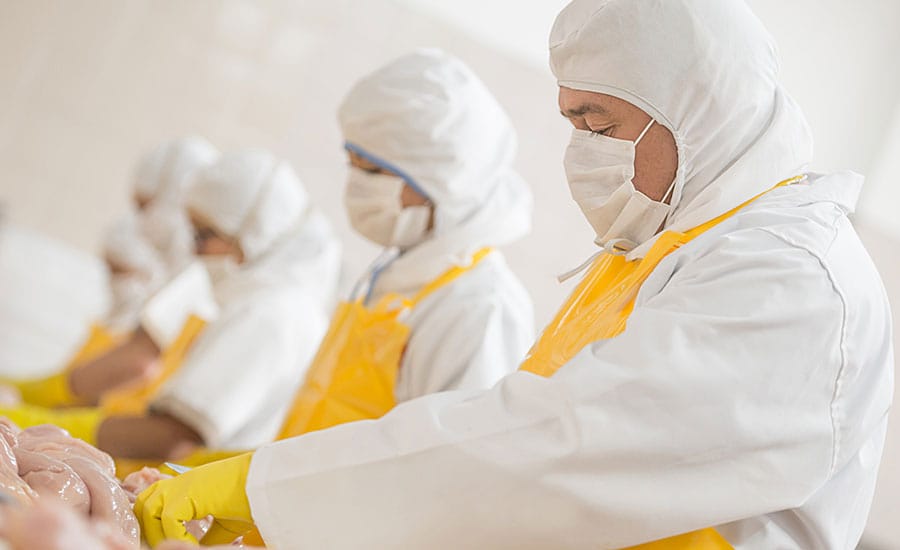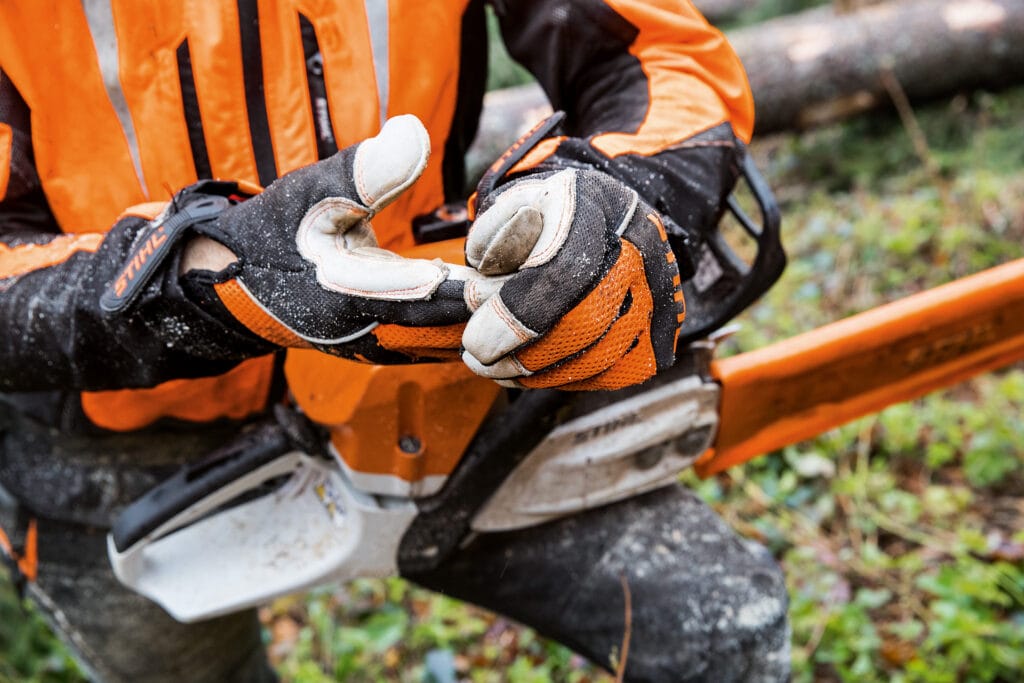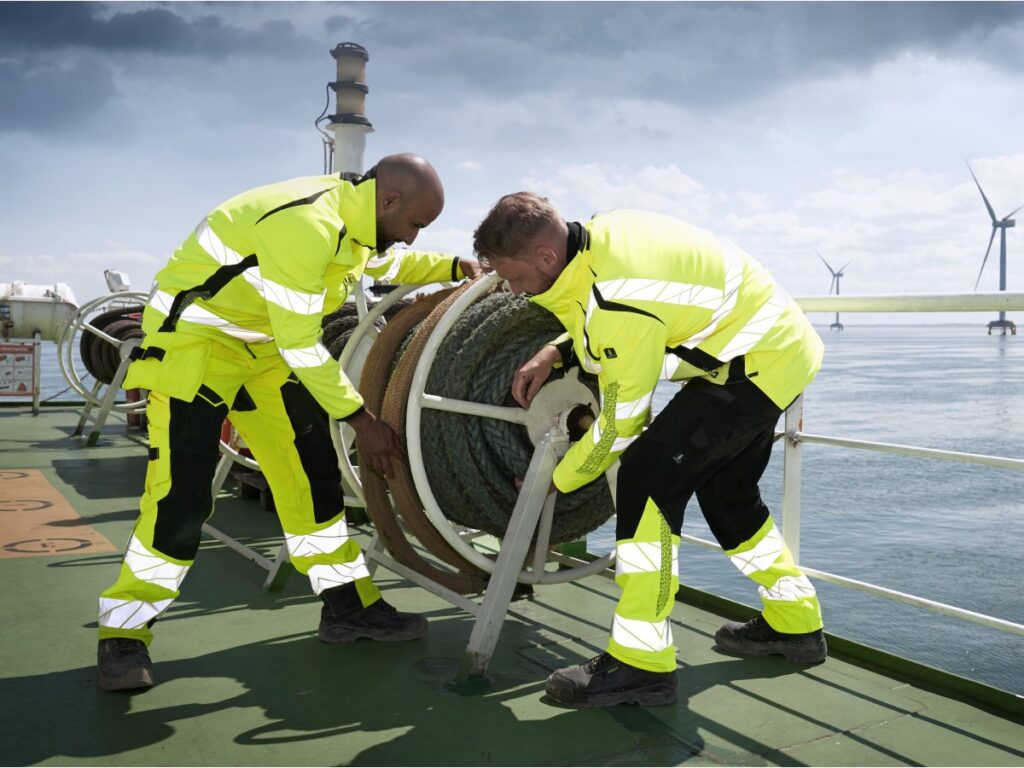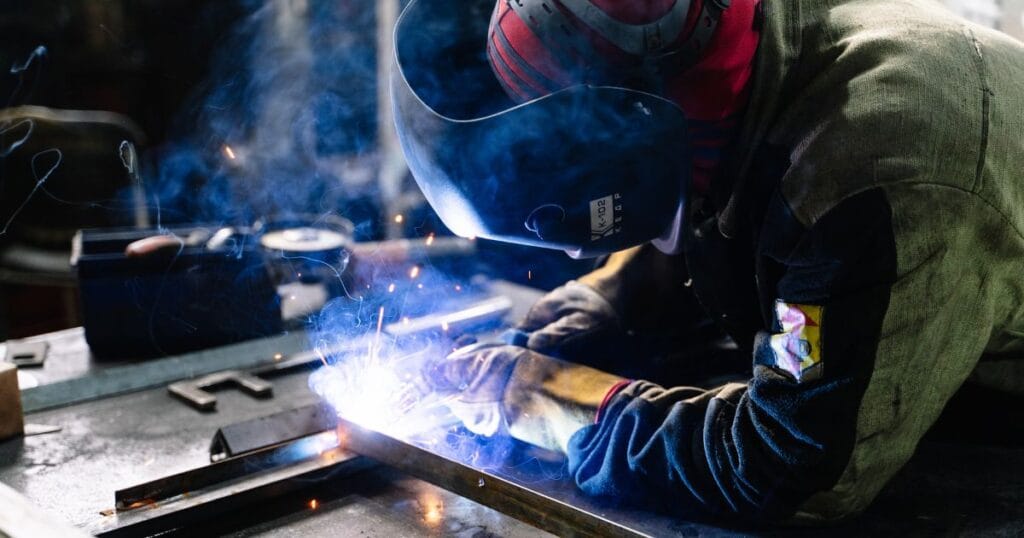
Step into a meat plant in Brazil, a dairy facility in Ethiopia, or a fish port in Chile, and you’ll immediately notice one thing: every worker is dressed in workwear designed for hygiene and protection. This isn’t just about uniforms—it’s about preventing contamination, protecting workers from cold and wet conditions, and staying compliant with strict food safety standards.
Unlike construction or mining, where durability and visibility are the main priorities, food processing has a unique challenge: hygiene must never be compromised. Even the smallest lapse—a torn glove, a wet cotton jacket, or a missing hairnet—can trigger a food recall worth millions, damage a brand’s reputation, and block exports to international markets.
At the same time, workers spend hours in cold rooms, slippery floors, and areas soaked with water and cleaning chemicals. Without the right workwear, they risk not only discomfort but serious injury: slips, chemical burns, cold stress, and even long-term respiratory problems from improper protection.
For distributors, agents, and buyers, this creates a stable, high-volume market. Food never stops being processed, and hygiene standards keep rising. Companies that can deliver the right balance of certified, durable, and affordable PPE stand to lock in long-term contracts.
Food processing workwear must ensure hygiene, cold protection, and compliance with HACCP/FDA/USDA rules. Essentials include waterproof aprons, slip-resistant boots, insulated jackets for cold rooms, disposable hairnets, gloves, and face masks. Materials should be waterproof, non-porous, and easy to sanitize (e.g., PVC, PU, nitrile).
Why Food Processing Requires Specialized Workwear
Food processing is unlike any other sector. Here’s why specialized PPE is critical:
1. Cold Room Conditions (0–8°C)
In meat and dairy plants, most work happens inside chilled environments to keep products fresh. Temperatures often stay between 0–8°C, and in blast freezers, it can drop below -20°C. Workers spend 6–10 hours per shift in these conditions.
- Risk: Cold stress, numbness, reduced dexterity, long-term joint pain.
- Example: A poultry plant in Argentina reported higher absenteeism during winter because workers wore cheap, non-insulated jackets. Production slowed as sick leave increased.
- Solution: Insulated PU-coated jackets and trousers that resist water and allow layering without bulk.
2. Constant Wet Environments
Food plants are hosed down daily with high-pressure water and disinfectants. Floors are almost always wet, and workers handle liquids like milk, blood, or sauces.
- Risk: Waterlogged fabrics like cotton absorb bacteria, creating hygiene hazards. Wet shoes increase slip accidents.
- Example: In a dairy facility in Uganda, cotton aprons absorbed milk and cleaning foam, causing bacterial growth. During an audit, the plant failed HACCP checks.
- Solution: Waterproof aprons made of PVC or PU, paired with SRC-rated slip-resistant boots that maintain grip even in greasy or wet conditions.
3. Hygiene Compliance
Food regulations are unforgiving. Standards like HACCP, FDA, and USDA require workwear that prevents contamination. That means:
-
No porous fabrics like cotton.
-
Regular cleaning and sanitizing of reusable PPE.
-
Mandatory disposable items (hairnets, gloves, masks) in high-risk zones.
-
Example: In 2021, a seafood exporter in Vietnam lost a contract with a European supermarket chain because inspectors found unprotected beards and uncovered hair in the processing area.
-
Lesson: Even minor oversights like missing hairnets can cost exporters access to international markets.
4. High Contamination Risk
Food recalls are extremely costly. In the U.S., the average recall costs around $10 million in direct expenses, not counting brand damage and lawsuits.
- Example: A bakery in Mexico had to recall thousands of bread packages after a worker’s torn glove ended up in a dough batch.
- Outcome: The plant switched to high-durability nitrile gloves to avoid future incidents.
Even developing markets are under scrutiny: African and South American exporters shipping to Europe, Japan, or the U.S. must meet the same hygiene levels. That means PPE suppliers have a strong selling point if they can guarantee certification.
5. Exposure to Chemicals
Sanitizers and disinfectants used in food processing are often alkaline or chlorine-based. If gloves or aprons are not chemical-resistant, workers can suffer burns.
- Case: A juice plant in Kenya reported skin burns when workers used latex gloves against chlorine wash. Latex dissolved quickly under exposure.
- Fix: They switched to EN 374-certified nitrile gloves, which resisted chemical breakdown and reduced injuries.
6. Professionalism and Brand Image
In modern food exports, how workers look matters. Uniform, clean, well-equipped staff reassure both auditors and international buyers.
- Case: A dairy cooperative in Morocco secured a supply contract with a French supermarket chain after investing in HACCP-compliant uniforms, hairnets, and branded jackets. Inspectors noted the improved professionalism of the team.
👉 In short:
Food processing requires waterproof, insulated, hygienic, and certified PPE. Any compromise—whether on material, certification, or maintenance—can directly lead to accidents, contamination, or export rejection.
Essential Workwear in Food Processing
Food processing requires a mix of reusable and disposable PPE. Below is a breakdown of the essentials:
| Workwear Item | Function | Material Recommendation | Standards / Notes |
|---|---|---|---|
| Waterproof Aprons | Protect from water, blood, sauces | PVC or PU-coated polyester | Easy to sanitize, non-porous |
| Slip-Resistant Boots | Prevent slips on wet, greasy floors | Nitrile-PVC blends, SRC-rated | EN ISO 20345 |
| Cold Room Jackets | Insulation in chilled/freezer areas | PU-coated, quilted polyester | EN 342 (cold environments) |
| Gloves (Disposable) | Prevent contamination, food-safe | Nitrile (powder-free, food grade) | EN ISO 374, FDA approved |
| Gloves (Reusable) | Chemical protection during sanitation | Nitrile or neoprene | Must resist chlorine, alkaline |
| Head Protection | Prevent hair contamination | Polypropylene disposable caps | HACCP / GMP compliance |
| Face Masks | Reduce contamination, protect workers | Non-woven fabric (3-ply) | FDA / WHO hygiene requirements |
| Eye Protection | Against chemical splashes during cleaning | Polycarbonate goggles | EN 166 (splash protection) |
International Standards: Hygiene & Safety
Food industry workwear is heavily regulated. Here’s a quick guide to the most relevant standards:
| Standard | Region / Body | What It Covers |
|---|---|---|
| HACCP | International | Hazard Analysis & Critical Control Points (hygiene) |
| FDA/USDA | USA | Food-contact safety, materials compliance |
| EN 13795 | Europe | Surgical / medical garments, extended to food hygiene |
| EN ISO 374 | International | Protective gloves against chemicals and microorganisms |
| EN 343 | Europe | Waterproof, breathable protective clothing |
| EN 342 | Europe | Cold environment protection (insulated clothing) |
👉 Takeaway: For exporters in Africa, South America, or the Middle East, compliance with FDA/USDA or EN standards is often a must for entering high-value export markets (EU, US, Japan).
Real-World Case Studies
Case 1: Brazil – Meat Processing Plant
In southern Brazil, a beef processing facility faced repeated slip accidents. Workers wore standard rubber boots, which provided minimal traction on greasy floors.
- Problem: 27 reported slip accidents in one year.
- Fix: The distributor introduced SRC-certified slip-resistant boots with nitrile-PVC soles.
- Result: Slip incidents dropped by 70% within 6 months, and the plant improved its HACCP audit results.
Case 2: Ethiopia – Dairy Processing Facility
An Ethiopian dairy exporter struggled with failed audits due to workers’ cotton coats, which absorbed milk and cleaning foam.
- Problem: Cotton coats became bacterial growth hotspots.
- Fix: Switched to PU-coated polyester jackets that resisted absorption and were easy to sanitize.
- Result: Passed EU inspections, secured a new export deal with a German supermarket chain.
Case 3: Chile – Fishery & Cold Storage
In a seafood cold-storage facility in Chile, workers had only basic cotton jackets in -18°C freezers.
- Problem: High absenteeism due to cold-related illness. Productivity loss estimated at 12%.
- Fix: Introduced EN 342-certified insulated jackets and trousers with waterproof outer shells.
- Result: Reduced worker sick leave, improved retention, and productivity rose by 10%.
Materials & Product Insights
The food industry cannot compromise on materials. Let’s break down the top options:
-
PVC (Polyvinyl Chloride)
- Waterproof, chemical-resistant, easy to wipe down.
- Heavy, less breathable.
- Ideal for aprons and boots.
-
PU (Polyurethane-Coated Polyester)
- Lighter, more flexible, still waterproof.
- Better comfort for long shifts.
- Preferred for jackets and trousers.
-
Nitrile Rubber
- Excellent chemical resistance (chlorine, detergents, solvents).
- More durable than latex.
- Essential for gloves in sanitation and handling.
-
Quilted / Insulated Polyester
- Used in cold room jackets and trousers.
- Must comply with EN 342 for cold protection.
- Often layered with PU coating for waterproofing.
👉 Lesson: Buyers in Africa, South America, and the Middle East often try to save costs by choosing cotton or basic rubber products—but in food processing, those choices fail audits and shorten product lifespan. Long-term contracts require certified, durable, hygienic materials.
Procurement Pitfalls & How to Avoid Them
Many distributors in emerging markets face recurring problems when sourcing food processing workwear. Here are the top pitfalls and how to address them:
-
Choosing Cotton Instead of Coated Fabrics
- Cotton absorbs liquids, blood, and chemicals.
- Leads to bacterial growth, audit failures, and high replacement costs.
- ✅ Solution: Always select PU- or PVC-coated fabrics for outer layers.
-
Overlooking Certification Requirements
- A low-cost glove may look fine but fails EN ISO 374 or FDA standards.
- In international audits, this leads to shipment rejections.
- ✅ Solution: Request certificates of conformity (CoC) and verify with accredited labs.
-
Underestimating Cold Storage Needs
- Many buyers underestimate the health risks of -18°C cold rooms.
- Basic jackets increase absenteeism and turnover.
- ✅ Solution: Insist on EN 342-certified cold protection garments for freezer zones.
-
Skipping Proper Footwear Testing
- Boots without SRC slip-resistance certification cause accidents and lawsuits.
- ✅ Solution: Always request slip-resistance test reports before bulk orders.
-
Ignoring Worker Comfort
- Heavy, stiff materials discourage compliance—workers stop wearing gear.
- ✅ Solution: Balance durability with comfort. PU-coated fabrics often outperform PVC in this regard.
ROI & Cost Savings
Investing in certified workwear is not just about compliance—it’s about financial efficiency.
Here’s a cost-benefit comparison:
| Scenario | Short-Term Cost | Long-Term Impact |
|---|---|---|
| Cheap cotton coats in dairy plant | Low purchase price | High contamination risk → audit failures → export bans |
| Certified PU-coated jackets | Higher purchase price (+25%) | Passed audits → secured export contracts worth millions |
| Basic rubber boots | Low purchase price | Frequent replacements + slip accidents → legal costs |
| Nitrile-PVC slip-resistant boots | Higher upfront cost (+30%) | Reduced accidents, fewer replacements, +70% ROI |
| No insulated cold room gear | Saved $50 per worker | Productivity loss (12% drop), high sick leave costs |
| EN 342 cold room jackets | Extra $40 per worker | Improved retention, +10% productivity, fewer absences |
👉 Key Point: A few extra dollars spent on certified PPE can save tens of thousands in lost productivity, accidents, and compliance penalties.
Trade & Market Opportunities
The global food industry is under pressure to meet higher hygiene and safety standards, and this creates opportunities for smart distributors and suppliers:
-
Africa
- Dairy, poultry, and fish processing are growing sectors.
- Exporters to EU markets must comply with HACCP, EN 343, and FDA rules.
- Opportunity: Affordable, certified aprons, gloves, and cold storage wear.
-
South America
- Brazil, Argentina, and Chile dominate meat and seafood exports.
- Audit failures are costly; certified PPE is non-negotiable.
- Opportunity: Partner with meat processing plants to supply high-volume reusable + disposable gear.
-
Middle East
- Strong demand for halal-compliant meat exports.
- Food safety audits from GCC and export markets are strict.
- Opportunity: Sell HACCP-compliant waterproof and chemical-resistant gear.
-
Asia (Central & South)
- Growing processed food exports to the Middle East and EU.
- PPE imports rising as local suppliers often lack certification.
- Opportunity: First movers supplying HACCP-certified PPE can lock in contracts.
Practical Checklist for Buyers & Traders
Before placing an order for food processing workwear, make sure you:
- ✅ Confirm compliance with HACCP, EN, or FDA standards.
- ✅ Request and verify certification documents from accredited labs.
- ✅ Match workwear to specific zones (e.g., production floor, sanitation, cold room).
- ✅ Balance durability and comfort to ensure workers actually use the PPE.
- ✅ Run a small pilot order before scaling up.
- ✅ Calculate ROI: compare upfront costs vs. long-term compliance savings.
Conclusion
Food processing is one of the most safety- and hygiene-sensitive industries in the world.
Workwear is not just protective clothing—it’s the frontline defense against contamination, audit failures, and productivity losses.
For distributors, agents, and traders in Africa, South America, and beyond, the opportunity is clear:
- Offer certified, durable, and comfortable PPE.
- Educate clients on ROI and compliance benefits.
- Position yourself as a trusted partner in helping food processors meet global standards.
👉 In the end, success in this market isn’t just about selling jackets or gloves—it’s about helping factories open doors to global exports.
Email: [email protected] 🌐 www.workwearsolutions.net
Zion Zhang
Recent Posts
 Thermo-Adaptive Fabrics: Dynamic Microclimate Control for Extreme Heat Environments2025年12月8日In high-temperature environments—whether in Middle Eastern […]
Thermo-Adaptive Fabrics: Dynamic Microclimate Control for Extreme Heat Environments2025年12月8日In high-temperature environments—whether in Middle Eastern […] Choosing the Right Fabric Blend by Industry2025年12月6日How CVC, TC, and High-Strength Fiber Blends Shape […]
Choosing the Right Fabric Blend by Industry2025年12月6日How CVC, TC, and High-Strength Fiber Blends Shape […] Functional Fabric Trends 20252025年12月3日Performance, Sustainability, and Smart Innovation Driving […]
Functional Fabric Trends 20252025年12月3日Performance, Sustainability, and Smart Innovation Driving […] Why Global Buyers Are Shifting Toward Lightweight Protection2025年12月2日Hygiene, Comfort, and Safety in a New Era of Performance […]
Why Global Buyers Are Shifting Toward Lightweight Protection2025年12月2日Hygiene, Comfort, and Safety in a New Era of Performance […] Top Workwear Fabric Innovations to Watch in the Next 3 Years2025年12月1日Workwear is entering a new era where materials science, […]
Top Workwear Fabric Innovations to Watch in the Next 3 Years2025年12月1日Workwear is entering a new era where materials science, […] Supplier Opportunity: Selling Tracking-Enabled Workwear as a Service2025年11月27日The Future of Safety, Compliance, and Workforce […]
Supplier Opportunity: Selling Tracking-Enabled Workwear as a Service2025年11月27日The Future of Safety, Compliance, and Workforce […]
CONTACT US
- Feel free to contact us any time. We will get back to you as soon as we can!
- +86-17303331701
